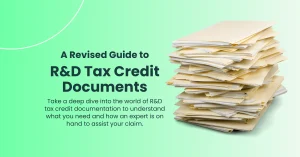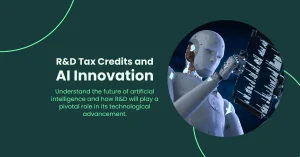Breaking down R&D tax credit changes 2023: Exciting news for R&D-intensive businesses
8 June 2023

It’s always a good idea to stay up to date with any R&D tax credit changes that may affect your business – especially laws and industry legislation. Why? Because when you keep up with the latest regulations, you’re able to make much better decisions – all while avoiding the consequences of non-compliance.
What are the R&D tax credit changes in 2023?
The government has introduced some significant changes in tax credits for small and medium-sized (SME) businesses in the budget 2023 encompassing changes in RDEC rates, pre-trading expenses, the introduction of a cap on payable tax credits, the inclusion of cloud and mathematics, and qualifying R&D activities. This is one of the many initiatives the government has taken to provide relief to R&D-intensive businesses across the UK – encouraging them to keep investing in innovation and technology.
This R&D relief scheme is aimed at reducing the cost of innovation, thereby imbuing a positive and progressive investment culture that benefits both SMEs and the UK economy.
So, if you’re looking to receive financial benefits through tax credits, keep reading because we’re breaking down the benefits of the changes in R&D tax credits in 2023.
Changes in RDEC rate
Firstly, the government has increased the Research and Development Expenditure Credit (RDEC) rate from 13% to 20%. This incentivises large companies engaging in qualifying R&D activities to invest more in research and development, thereby promoting innovation and contributing to the growth of the UK economy. You can use our free R&D tax credit calculator to find out an estimation of the amount that can be claimed back from HMRC.
Pre-trading expenses after April 2023
Secondly, the SME R&D tax credit scheme has been extended to include pre-trading expenses incurred on or after 1st April 2023. This is fantastic news for small and medium-sized enterprises (SMEs) that carry out qualifying R&D activities. They’ll now be able to claim tax relief on their R&D expenses from the start of their business, which is a great incentive for entrepreneurs and start-ups.
Introducing a cap on payable tax credits
The budget has also introduced a cap on the payable tax credit that SMEs can claim through the R&D tax credit scheme. The cap is set at three times the company’s total PAYE and national insurance liability for the year. This is to ensure that the R&D tax credit scheme is targeted towards SMEs that have a genuine R&D focus and are investing in innovation.
Inclusion of cloud and mathematics businesses
Another R&D tax credit change was the redefinition of research and development (R&D), meaning pure mathematics will be included in R&D from now on. This means that businesses that carry out pure mathematics research can now claim tax relief for their R&D activities.
The relief tax relief will also be available for cloud computing and data costs from 1st April 2023. This is great news for businesses that invest in these areas, as they’ll be able to claim tax relief on their R&D investments.
The claim notification form
When applying for R&D tax credits for the first time, it is essential to notify HMRC in advance through the claim notification form. You are responsible for notification if:
- This is your initial claim.
- You claimed for the previous tax year but submitted the claim after the deadline of the claim notification period (which concludes 6 months after the end of the accounting period).
- Your last claim was lodged over 3 years before the final date of the claim notification period.
The claim notification form must be submitted no later than 6 months after the conclusion of the relevant accounting period. Failure to meet this deadline will render the claim invalid. The following information needs to be provided:
- The company’s Unique Taxpayer Reference (UTR), matches the one in your Company Tax Return.
- Contact details of the primary senior internal contact within the company responsible for the R&D claim (e.g., a company director).
- Contact information of any agent involved in the R&D claim.
- Start and end dates of the accounting period for which you are claiming tax relief or expenditure credit, aligning with the dates in your Company Tax Return.
- Start and end dates of the period of account.
- A concise overview of the planned high-level activities, such as the purpose of software development, to demonstrate alignment with the standard definition of R&D. Note that supporting evidence is not required on the form, but additional information will be necessary on the supplementary form.
Requirements for new claims
Starting from August 8, 2023, it is now a requirement to provide an additional information form (AIF) that includes comprehensive financial and technical details related to your development work.
Failure to submit the AIF will lead to an automatic rejection of your claim by HMRC. But don’t worry, here’s what you need to provide to prevent such mishaps:
Technical information (including projects’ details)
It is essential to furnish a comprehensive description of one or more projects included in your claim. These descriptions should be organised into these questions:
- What is the primary field of science or technology involved?
- What was the initial level of scientific or technological understanding that you intended to enhance?
- What progress in scientific or technical knowledge were you striving to accomplish?
- What uncertainties in scientific or technological aspects did your project encounter?
- How did your project aim to address and resolve these uncertainties?
- Specify the scheme to which you are applying and indicate the amount you are seeking to claim.
It is not obligatory to provide descriptions for all your projects. The quantity of projects you should describe is contingent upon the number of projects for which you are submitting claims.
Financial information
You will need to furnish a comprehensive breakdown of your R&D qualifying expenditures such as staff costs, subcontractors costs, software, consumables, data license costs and more.
Qualifying indirect activities
You will also be required to inform HMRC about the portion of your project expenditure allocated to qualifying indirect activities. Indirect activities encompass tasks that provide support to your development work but do not directly contribute to scientific or technological advancements, such as project management and analysis. It’s important to note that spending on cloud computing or data licensing cannot be considered as part of the expenditure on indirect activities.
Company details
Alongside the above-mentioned details, you will furnish details about your company, such as:
- Your company’s Unique Taxpayer Reference (UTR) number
- Employer PAYE reference number
- VAT registration number
- Business type, including its current Standard Industrial Classification (SIC) code
- Contact information for the principal senior individual at your company overseeing the R&D claim
- Contact details for any agent who assisted in preparing your claim.
Measures against abuse
To prevent any misuse of the R&D tax relief initiative, authorities have introduced certain measures. Moving forward, companies must digitally submit all claims, with endorsement by a senior officer of the company. Moreover, companies will need to notify HMRC in advance of a claim, unless they have already made a claim in the last three accounting periods. Moreover, they will need to provide information about any agents who advised the company to make the claim.
Qualifying R&D activities
Lastly, the budget has made R&D changes to define the qualifying R&D activities, which will allow more businesses to benefit from the R&D tax rebate. These changes include expanding the definition of qualifying indirect activities such as scientific and technical information services, maintenance and administrative activities, ancillary activities like staffing and equipment maintenance, developing new testing methods, conducting feasibility studies for R&D direction and so on while broadening the definition of software R&D activities. These changes will ensure that more businesses can claim tax relief on their R&D investments.
Let’s put it all together
In conclusion, the recent R&D tax credit changes in 2023 present a game-changing opportunity for businesses in the UK. With a focus on supporting R&D-intensive SMEs, the government has demonstrated its commitment to fostering innovation and technological advancement. The increase in the Research and Development Expenditure Credit (RDEC) rate for large companies incentivises further investment in R&D, driving growth and innovation in the UK economy. SMEs also benefit from the extension of the SME R&D tax credits scheme to include pre-trading expenses, allowing them to claim tax relief from the very beginning of their business journey.
Moreover, the inclusion of pure mathematics, cloud computing, and data costs in the definition of R&D activities expands the scope of eligibility, enabling businesses in these areas to access tax relief on their R&D investments. These initiatives, coupled with measures to prevent abuse and broader qualifying criteria, create an environment that encourages businesses to invest in R&D, paving the way for a more innovative and prosperous future.
How can we help?
Overall, R&D tax relief changes in the budget are significant and positive for the UK’s economy. They’ll encourage businesses to invest more in innovation and technology, which will ultimately lead to long-term economic growth and prosperity.
And to ensure you’re always informed and well compensated for your claims, Alexander Clifford is here to provide the support and guidance you need to stay ahead and succeed. We’re well-versed in the R&D claim process and have best-in-class expertise to help you claim credits precisely and accurately based on the latest guidelines. Having second thoughts? Check out our 5-star reviews and personal recommendations, or speak to a specialist now.







